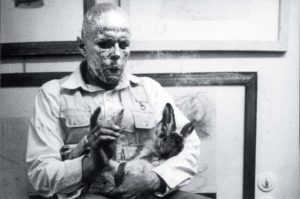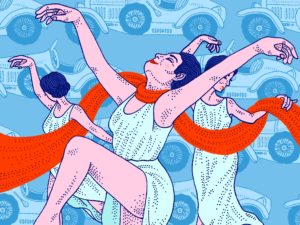The Inversion of Traditional Aesthetics: The Ugly as Art
The numerous schools of modern art that have appeared and developed share several things in common: They invert conventional aesthetics. They take ugliness as beauty, and they aim to shock, even to the point of being as ghastly as the artist’s imagination allows.
Marcel Duchamp signed his name on a urinal and named it “Fountain,” to be put on display for the public in New York. Though display of the object was refused, the gesture was considered a clever joke among Duchamp’s peers in the art world, and later artists and academics have thought it the height of creativity. This is the environment in the art world whereby classical easel painting was marginalized, and installation art rose to prominence. In 1958, Yves Klein held the Void exhibition at the Iris Clert Gallery in Pairs—the displayed works turning out to be empty walls.
A major figure of the postwar German avant-garde, Joseph Beuys, covered his head with honey and gold leaf in 1965, murmuring nonstop for three hours with a dead hare in his arms, in the work “How to Explain Pictures to a Dead Hare.” In Beuys’s view, everyone could be an artist. One anecdote goes that a dubious onlooker could not help but question him: “You talk about everything under the sun, except art!” Beuys’ reported response: “Everything under the sun is art!”
In 1961, Piero Manzoni, a key figure of the avant-garde, put his own feces in 90 cans, called them artworks, and put them up for sale under the name “Merda d’artista” (Artist’s Shit). In 2015, one of the cans was sold in London for a record price of 182,500 pounds, or about $US240,000, hundreds of times the price of the same weight in gold. He also signed his name to the buttocks of a nude woman, calling the piece “Sculture viventi” (living sculpture).
In China, there was the nude “artist” who coated his body with honey and fish oil to attract flies. Desecration of the body seems intended to communicate the idea that life is cheap, ugly, and disgusting.
In the BBC documentary Beijing Swings about “extreme artists” in China, so-called performance art included the performative consumption of the corpse of a dead fetus. Waldemar Januszczak, host of the documentary, commented, “China is producing the most outrageous and darkest art, of anywhere in the world.” In fact, this is a result of the pursuit of demon nature. Some of these so-called modern artworks are so filthy and shameless that they exceed the mental endurance of normal people. Such behavior of the avant-garde is the Cultural Revolution of the art world.
Those who support modernism have taken to the trend like a duck to water, but painters truly proficient in the technical skill of painting have a tough time. Painters and sculptors who adhere to strict tradition, who master their craft through painstaking practice, have been squeezed out of the art world. John William Godward, the English Victorian neoclassicist painter associated with the Pre-Raphaelite Brotherhood, felt that he was discriminated against given that his style of realistic classical painting fell out of favor with the rise of Picasso’s modernist works. In 1922, he committed suicide, and was said to have written in his suicide note: “The world is not big enough for myself and a Picasso.”
Similar methods were adopted to ruin music. Authentic music conforms with musical theory and order. Musical tuning and the keys and modes it produces all derive from harmonious natural patterns. The universe created by the divine is harmonious. Humans are able to appreciate and participate in the harmony of the universe, and thus create beauty, since humans are also created by the divine.
Modern atonal music rejects ideas like tonality, chords, and melody, and lacks order in its structure. Such music is a revolt against divinely imparted classical music. Atonal music violates the harmony in the universe, which is why many audiences find it unpleasant. Modernist musicians argue, based on their warped theories of aesthetics, that audience members must train their ears to get used to such music, so they, too, will enjoy it.
Arnold Schoenberg, one of the founders of modern music, introduced the “twelve-tone system,” a fundamentally atonal structure that marked the creation of anti-classical musical technique. Schoenberg’s music was considered the negation of all German musical culture until then, the betrayal of taste, feeling, tradition, and all aesthetic principles. His music was called “cocaine” by Germans at the time: “To perform Schoenberg means the same as to open a cocaine bar for the people. Cocaine is poison. Schoenberg’s music is cocaine.” In later generations, a music critic assessed him thus: “It is a measure of the immensity of the man’s achievement that, fifty years after his death, he can still empty any hall on earth.”
What led to the widespread acceptance of Schoenberg was the musical theories of Theodor W. Adorno, an important figure in the Frankfurt School. In Adorno’s 1949 work, Philosophy of Modern Music, he attempted to use theory to demonstrate that Schoenberg’s twelve-tone method was the peak of musical composition. This set the stage for the widespread acceptance of Schoenberg’s system by later generations of composers and music critics. Since then, numerous musicians have emulated Schoenberg, and his avant-garde style has had a major impact on the postwar music world.
After destroying tradition with modern music, avant-garde art used rock-and-roll to supplant the role of classical music in people’s lives. Sidney Finkelstein, the leading music theorist of the Communist Party USA, openly declared that the boundaries between classical and popular should be eliminated. At around the same time, strongly rhythmic rock music was gaining an increasing foothold in the United States, as classical and traditional music was squeezed out and marginalized.
The characteristics of rock-and-roll include inharmonious sounds, unstructured melody, strong rhythmic beats, and emotional conflicts and contradictions—quite similar to the communist idea of struggle. According to the Records of the Grand Historian by China’s foremost ancient historian Sima Qian, only when sound conforms to morality can it be called music. Typically, the lives of rock-and-roll musicians are full of sex, violence, and drugs.
After rock-and-roll, other forms of music, like rap, appeared in the United States and gained popularity. Rap lyrics are replete with swear words and obscenities, and the music makes plain its rebellion against tradition and society through the use of drugs, violence, swearing, and promiscuity. As the morality of society as a whole declines, such “art forms,” previously regarded as subcultures, have made their way into the wider society and are even sought after by mainstream performance venues.
We have so far focused on the current circumstances in the worlds of art and music. In fact, the entire artistic world has been greatly impacted, and the influence of the modern art movement can be seen in the deviation from traditional ideas, methods, and skills in areas like sculpture, architecture, dance, decoration, design, photography, movies, and more. Many people who are engaged in modern art are strongly influenced by communist ideology. For example, the founder of modern dance, Isadora Duncan, was bisexual and atheist. She objected to ballet, calling it ugly and unnatural. She and one hundred students performed in Moscow for Lenin and used “The Internationale” as the main dance theme.
As for why these deviations exist, become a trend, or even become mainstream, this is closely related to how communism has corrupted traditional arts that were divinely inspired. On the surface, of course, this is not apparent, and the situation seems to be a form of self-deception that has been widely accepted—the notion that if there’s a theory behind it, it’s art.
If people look closely at the differences between avant-garde art and traditional art, they will find that the artists of the Renaissance not only used art to praise God, but also to an even greater extent presented beauty in a manner that engendered feelings of truth and goodness in the human heart, and in so doing, maintained the morality of society.
On the other hand, the various mutated forms of avant-garde art try to reverse all the achievements of the Renaissance. They lead people to be attracted to ugliness, which brings forth demonic nature in people: Dark, decadent, depraved, violent, evil, and other negative thoughts gain ascendency. The modern slander of the divine has led people today to be alienated not only from God but also from their own inner divinity, community, traditional values, and morality.
From Chapter Eleven: Desecrating the Arts

How to Explain Pictures to a Dead Hare

Founder of modern dance, Isadora Duncan

